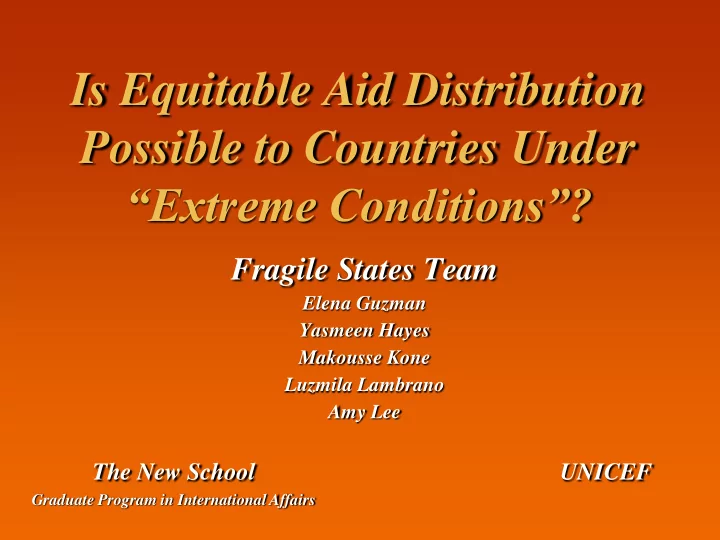

Is Equitable Aid Distribution Possible to Countries Under “Extreme Conditions”? Fragile States Team Elena Guzman Yasmeen Hayes Makousse Kone Luzmila Lambrano Amy Lee The New School UNICEF Graduate Program in International Affairs
Introduction Fragile State International Donor Community Recommendations
Definition of Fragile State A government that does not have the capacity, willingness or sovereignty to function in delivering basic public goods and services, safety and security to its population due to internal and/or external factors. Photo: www.imi.org.uk/ conf2004/awards2004.htm
Characteristics of Fragile States State Capacity State Willingness State Sovereignty Loss of territorial and Lack of political Fragmented territory border control commitment to poverty reduction and human rights Inability to provide Absence or lack of anti- Dispersed population basic service and goods poverty policies and to the population social safety nets Poor governance and Partiality towards Foreign occupation political power exclusive groups, elites or private sector interests (TNCs) Low competence in macroeconomic management ( low income per capita)
Harmonised Alignment Programme Aid Donor Behavior Projects Global Funds Capacity Technical Aid Cooperation Recipient and Instruments * Will Entity Multi-Donor Fragile States Trust Funds Environment Social Funds, CDD Humanitarian Recipient market Models Aid economy (TNCs / Private Sector Joint Donor Programmes Nations IFIs World Bank IMF ADB
Needs and Assessment Stages of Fragile States Natural disaster Stabilization/ Transition/ Conflict Effective Post-Crisis State Near collapse or collapsed gov. institutions Crisis Intermediate Phase Stable Phase Immediate Service delivery Crisis transition Development Poverty reduction strategies Photo: World Photos.com
Aid Vehicles
Aid Selectivity Model Dominant paradigm of aid allocation Policy and institutional performance Preference to countries that can use external resources more effectively
World Bank Model Performance Based Allocation - CPIA Allocation per capita = f ( PR 2.0 , GNIPC -0.125 ) Source: IDA 2003
World Bank Model LICUS (Low Income Countries Under Stress) Based on CPIA score with emphasis on policy, institutions and governance Adds indicators: policy management capacity, service delivery capacity and influence of citizens on government Cost of being LICUS Reduces annual growth rate by 2.3% when compared to other developing economies Cost in overcoming this label can amount up to 4.6 times the state’s GDP Chance of achieving a sustained turnaround is 1.8% According to a model, states are likely to remain LICUS for as much as 56 years
Nation Donor Models Australia, Japan: Help others to ensure own security and prosperity France: Colonial linkages Netherlands, Sweden, Switzerland: Poverty reduction United States: Foreign policy Photo: World Photos.com
Markets – Transnational Corporations (TNCs) Exploitation of natural resources such as oil, diamonds or other minerals Conflicting interests with donors and government TNCs may have a positive impact Photo: BBC News Polluting Nigeria Photo: Micah Goulart
Conclusion No correlation between the aid allocation processes and actual conditions of a fragile state Diversity of processes by which aid is allocated does not coincide to find a common ground with realities of a fragile state The two are facing opposite directions: 1) Aid allocation seeking its prerequisites and demands 2) Fragile states seeking to survive, unable to fulfill these requirements Cleavage created between them creates the lacuna that allows for their neglect within the aid distribution equation http://www.fotosearch.com/PHT258/paa258000031/
Recommendations Country-specific approach Leadership roles of fragile states Appropriate and timely use of vehicles for delivering aid Evaluate donors based on capacity, willingness and flexibility and hold them accountable UNICEF seeks partnership with donors that possess the best qualities Market and private sector strategies, “name and shame” Database of all elements of donor-fragile state aid dynamics
Is equitable aid distribution possible to countries under “extreme conditions”?
Recommend
More recommend